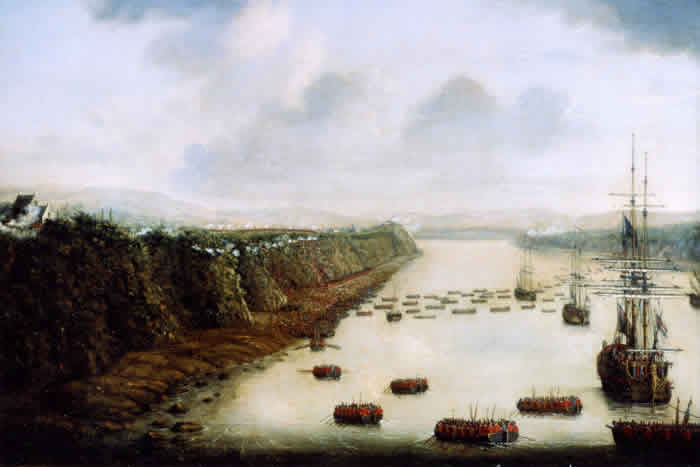

BATTLE OF THE PLAINS OF ABRAHAM
Context
The Anse-au-Foulon Landing
Initially, the British landing was to occur on September 8, in a location immediately below Pointe-aux-Trembles (present-day Neuville). However, heavy rain delayed the execution of the plan and finally forced the general to give it up. While he was waiting, however, he took advantage of this opportunity to explore the coast, this time downstream from Cap-Rouge. It was then, probably, that he decided to land at Anse-au-Foulon. Until then he had followed his corporals' plan. This time he would change everything and stick to his own strategy.
Although this choice was questionable because of the problems associated with the area – a cliff to climb, the positioning midway between Montcalm's and Bougainville's troops, the difficulty of retreating if it became necessary, the impossibility of using the artillery –, this plan had a few advantages compared with the one involving operations further upstream. Landing closer to town and as a result near the Île d'Orléans camp and the Pointe-Lévy battery, would allow the General to repatriate his men holding defensive positions there. Wolfe could thus count on 1,000 or so additional men, thus increasing his forces from 3,600 to 4,600.
Late in the evening of September 12, they were ready to attack. First, a diversion was created to draw the attention of the French Army away from Anse-au-Foulon. The Sutherland ship was positioned opposite Cap-Rouge to keep the Bougainville troops occupied, while most of the fleet moved back and forth in front of Beauport and near the St. Charles River. Finally, the artillery was kept busy at Pointe-Lévy and with the shelling of Québec.
Meanwhile, the men who were on the ships anchored off Cap-Rouge began to board small boats. Approximately 1,800 soldiers made up the first wave. Around 2:00 a.m., they took advantage of the ebbing tide to flow silently with the current.

As they came near the coast, the first British boats were hailed by the French sentinels. How? There are several versions to the story. Some say that the sentinels asked to know what regiment the men belonged to, to which a Scottish captain who spoke English, probably Donald MacDonald and not Fraser as is often claimed109, allegedly answered "Marine" (Navy). Other accounts claim that the question was "Qui vive?" (Who's there?), to which MacDonald allegedly answered, "France." Be that as it may, apparently the French Army had not established any special procedure or password for such occasions.
The first soldiers who landed around 4:00 a.m. belonged to the Light Infantry. This group of 24 volunteers under Captain William Delaune's command had been given the mission to attack the French sentinels standing at the top of the cliff, by taking the now famous path (known today as Gilmour Hill). A short time later he was joined by Lieutenant Colonel William Howe, the Light Infantry Commander, and by the rest of the regiment. However, the boats had been carried a little too far downstream, which was likely to jeopardize the mission. Faced with this emergency, before dawn broke, Howe made the decision to go up the cliff right then and there with three companies, from his position, and he ordered Captain Delaune and his men to return to the path located further west. Howe's soldiers were the first to arrive, and they put to flight the militiamen commanded by Captain Vergor. From then on the landing of British troops accelerated. At 8:00 a.m., the men led by Burton and Carleton, who had previously been ordered to take their positions on the Île d'Orléans and Pointe-Lévy on the south shore opposite Anse-au-Foulon, made up the rest of the army.
